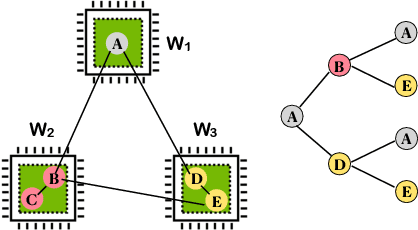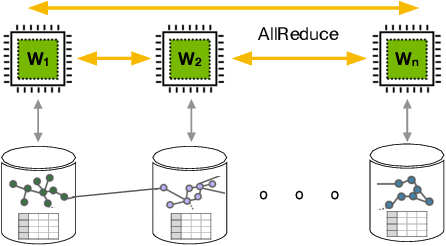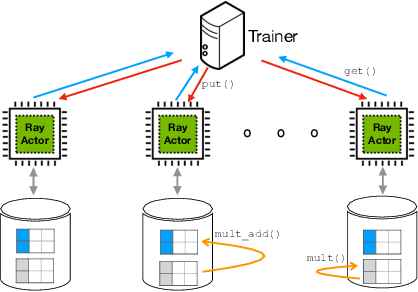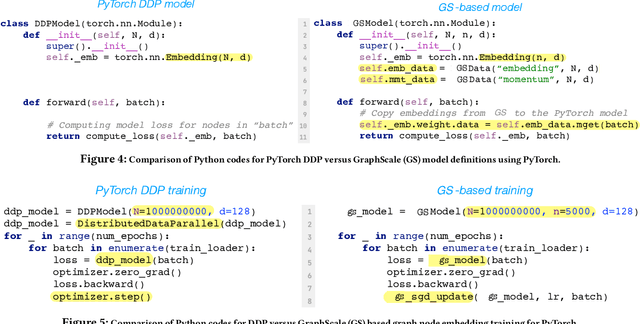Yujun Yan
Non-exchangeable Conformal Prediction for Temporal Graph Neural Networks
Jul 02, 2025Abstract:Conformal prediction for graph neural networks (GNNs) offers a promising framework for quantifying uncertainty, enhancing GNN reliability in high-stakes applications. However, existing methods predominantly focus on static graphs, neglecting the evolving nature of real-world graphs. Temporal dependencies in graph structure, node attributes, and ground truth labels violate the fundamental exchangeability assumption of standard conformal prediction methods, limiting their applicability. To address these challenges, in this paper, we introduce NCPNET, a novel end-to-end conformal prediction framework tailored for temporal graphs. Our approach extends conformal prediction to dynamic settings, mitigating statistical coverage violations induced by temporal dependencies. To achieve this, we propose a diffusion-based non-conformity score that captures both topological and temporal uncertainties within evolving networks. Additionally, we develop an efficiency-aware optimization algorithm that improves the conformal prediction process, enhancing computational efficiency and reducing coverage violations. Extensive experiments on diverse real-world temporal graphs, including WIKI, REDDIT, DBLP, and IBM Anti-Money Laundering dataset, demonstrate NCPNET's capability to ensure guaranteed coverage in temporal graphs, achieving up to a 31% reduction in prediction set size on the WIKI dataset, significantly improving efficiency compared to state-of-the-art methods. Our data and code are available at https://github.com/ODYSSEYWT/NCPNET.
Judging with Many Minds: Do More Perspectives Mean Less Prejudice?
May 26, 2025Abstract:LLM-as-Judge has emerged as a scalable alternative to human evaluation, enabling large language models (LLMs) to provide reward signals in trainings. While recent work has explored multi-agent extensions such as multi-agent debate and meta-judging to enhance evaluation quality, the question of how intrinsic biases manifest in these settings remains underexplored. In this study, we conduct a systematic analysis of four diverse bias types: position bias, verbosity bias, chain-of-thought bias, and bandwagon bias. We evaluate these biases across two widely adopted multi-agent LLM-as-Judge frameworks: Multi-Agent-Debate and LLM-as-Meta-Judge. Our results show that debate framework amplifies biases sharply after the initial debate, and this increased bias is sustained in subsequent rounds, while meta-judge approaches exhibit greater resistance. We further investigate the incorporation of PINE, a leading single-agent debiasing method, as a bias-free agent within these systems. The results reveal that this bias-free agent effectively reduces biases in debate settings but provides less benefit in meta-judge scenarios. Our work provides a comprehensive study of bias behavior in multi-agent LLM-as-Judge systems and highlights the need for targeted bias mitigation strategies in collaborative evaluation settings.
Transfer Faster, Price Smarter: Minimax Dynamic Pricing under Cross-Market Preference Shift
May 22, 2025Abstract:We study contextual dynamic pricing when a target market can leverage K auxiliary markets -- offline logs or concurrent streams -- whose mean utilities differ by a structured preference shift. We propose Cross-Market Transfer Dynamic Pricing (CM-TDP), the first algorithm that provably handles such model-shift transfer and delivers minimax-optimal regret for both linear and non-parametric utility models. For linear utilities of dimension d, where the difference between source- and target-task coefficients is $s_{0}$-sparse, CM-TDP attains regret $\tilde{O}((d*K^{-1}+s_{0})\log T)$. For nonlinear demand residing in a reproducing kernel Hilbert space with effective dimension $\alpha$, complexity $\beta$ and task-similarity parameter $H$, the regret becomes $\tilde{O}\!(K^{-2\alpha\beta/(2\alpha\beta+1)}T^{1/(2\alpha\beta+1)} + H^{2/(2\alpha+1)}T^{1/(2\alpha+1)})$, matching information-theoretic lower bounds up to logarithmic factors. The RKHS bound is the first of its kind for transfer pricing and is of independent interest. Extensive simulations show up to 50% lower cumulative regret and 5 times faster learning relative to single-market pricing baselines. By bridging transfer learning, robust aggregation, and revenue optimization, CM-TDP moves toward pricing systems that transfer faster, price smarter.
Exploring Consistency in Graph Representations:from Graph Kernels to Graph Neural Networks
Oct 31, 2024Abstract:Graph Neural Networks (GNNs) have emerged as a dominant approach in graph representation learning, yet they often struggle to capture consistent similarity relationships among graphs. While graph kernel methods such as the Weisfeiler-Lehman subtree (WL-subtree) and Weisfeiler-Lehman optimal assignment (WLOA) kernels are effective in capturing similarity relationships, they rely heavily on predefined kernels and lack sufficient non-linearity for more complex data patterns. Our work aims to bridge the gap between neural network methods and kernel approaches by enabling GNNs to consistently capture relational structures in their learned representations. Given the analogy between the message-passing process of GNNs and WL algorithms, we thoroughly compare and analyze the properties of WL-subtree and WLOA kernels. We find that the similarities captured by WLOA at different iterations are asymptotically consistent, ensuring that similar graphs remain similar in subsequent iterations, thereby leading to superior performance over the WL-subtree kernel. Inspired by these findings, we conjecture that the consistency in the similarities of graph representations across GNN layers is crucial in capturing relational structures and enhancing graph classification performance. Thus, we propose a loss to enforce the similarity of graph representations to be consistent across different layers. Our empirical analysis verifies our conjecture and shows that our proposed consistency loss can significantly enhance graph classification performance across several GNN backbones on various datasets.
GraphScale: A Framework to Enable Machine Learning over Billion-node Graphs
Jul 22, 2024



Abstract:Graph Neural Networks (GNNs) have emerged as powerful tools for supervised machine learning over graph-structured data, while sampling-based node representation learning is widely utilized in unsupervised learning. However, scalability remains a major challenge in both supervised and unsupervised learning for large graphs (e.g., those with over 1 billion nodes). The scalability bottleneck largely stems from the mini-batch sampling phase in GNNs and the random walk sampling phase in unsupervised methods. These processes often require storing features or embeddings in memory. In the context of distributed training, they require frequent, inefficient random access to data stored across different workers. Such repeated inter-worker communication for each mini-batch leads to high communication overhead and computational inefficiency. We propose GraphScale, a unified framework for both supervised and unsupervised learning to store and process large graph data distributedly. The key insight in our design is the separation of workers who store data and those who perform the training. This separation allows us to decouple computing and storage in graph training, thus effectively building a pipeline where data fetching and data computation can overlap asynchronously. Our experiments show that GraphScale outperforms state-of-the-art methods for distributed training of both GNNs and node embeddings. We evaluate GraphScale both on public and proprietary graph datasets and observe a reduction of at least 40% in end-to-end training times compared to popular distributed frameworks, without any loss in performance. While most existing methods don't support billion-node graphs for training node embeddings, GraphScale is currently deployed in production at TikTok enabling efficient learning over such large graphs.
* Published in the Proceedings of the 33rd ACM International Conference on Information and Knowledge Management (CIKM 2024), 8 Pages, 12 Figures
Sharpness-diversity tradeoff: improving flat ensembles with SharpBalance
Jul 17, 2024



Abstract:Recent studies on deep ensembles have identified the sharpness of the local minima of individual learners and the diversity of the ensemble members as key factors in improving test-time performance. Building on this, our study investigates the interplay between sharpness and diversity within deep ensembles, illustrating their crucial role in robust generalization to both in-distribution (ID) and out-of-distribution (OOD) data. We discover a trade-off between sharpness and diversity: minimizing the sharpness in the loss landscape tends to diminish the diversity of individual members within the ensemble, adversely affecting the ensemble's improvement. The trade-off is justified through our theoretical analysis and verified empirically through extensive experiments. To address the issue of reduced diversity, we introduce SharpBalance, a novel training approach that balances sharpness and diversity within ensembles. Theoretically, we show that our training strategy achieves a better sharpness-diversity trade-off. Empirically, we conducted comprehensive evaluations in various data sets (CIFAR-10, CIFAR-100, TinyImageNet) and showed that SharpBalance not only effectively improves the sharpness-diversity trade-off, but also significantly improves ensemble performance in ID and OOD scenarios.
Enhancing Size Generalization in Graph Neural Networks through Disentangled Representation Learning
Jun 07, 2024Abstract:Although most graph neural networks (GNNs) can operate on graphs of any size, their classification performance often declines on graphs larger than those encountered during training. Existing methods insufficiently address the removal of size information from graph representations, resulting in sub-optimal performance and reliance on backbone models. In response, we propose DISGEN, a novel and model-agnostic framework designed to disentangle size factors from graph representations. DISGEN employs size- and task-invariant augmentations and introduces a decoupling loss that minimizes shared information in hidden representations, with theoretical guarantees for its effectiveness. Our empirical results show that DISGEN outperforms the state-of-the-art models by up to 6% on real-world datasets, underscoring its effectiveness in enhancing the size generalizability of GNNs. Our codes are available at: https://github.com/GraphmindDartmouth/DISGEN.
Medformer: A Multi-Granularity Patching Transformer for Medical Time-Series Classification
May 24, 2024Abstract:Medical time series data, such as Electroencephalography (EEG) and Electrocardiography (ECG), play a crucial role in healthcare, such as diagnosing brain and heart diseases. Existing methods for medical time series classification primarily rely on handcrafted biomarkers extraction and CNN-based models, with limited exploration of transformers tailored for medical time series. In this paper, we introduce Medformer, a multi-granularity patching transformer tailored specifically for medical time series classification. Our method incorporates three novel mechanisms to leverage the unique characteristics of medical time series: cross-channel patching to leverage inter-channel correlations, multi-granularity embedding for capturing features at different scales, and two-stage (intra- and inter-granularity) multi-granularity self-attention for learning features and correlations within and among granularities. We conduct extensive experiments on five public datasets under both subject-dependent and challenging subject-independent setups. Results demonstrate Medformer's superiority over 10 baselines, achieving top averaged ranking across five datasets on all six evaluation metrics. These findings underscore the significant impact of our method on healthcare applications, such as diagnosing Myocardial Infarction, Alzheimer's, and Parkinson's disease. We release the source code at \url{https://github.com/DL4mHealth/Medformer}.
Interpretable Sparsification of Brain Graphs: Better Practices and Effective Designs for Graph Neural Networks
Jun 26, 2023Abstract:Brain graphs, which model the structural and functional relationships between brain regions, are crucial in neuroscientific and clinical applications involving graph classification. However, dense brain graphs pose computational challenges including high runtime and memory usage and limited interpretability. In this paper, we investigate effective designs in Graph Neural Networks (GNNs) to sparsify brain graphs by eliminating noisy edges. While prior works remove noisy edges based on explainability or task-irrelevant properties, their effectiveness in enhancing performance with sparsified graphs is not guaranteed. Moreover, existing approaches often overlook collective edge removal across multiple graphs. To address these issues, we introduce an iterative framework to analyze different sparsification models. Our findings are as follows: (i) methods prioritizing interpretability may not be suitable for graph sparsification as they can degrade GNNs' performance in graph classification tasks; (ii) simultaneously learning edge selection with GNN training is more beneficial than post-training; (iii) a shared edge selection across graphs outperforms separate selection for each graph; and (iv) task-relevant gradient information aids in edge selection. Based on these insights, we propose a new model, Interpretable Graph Sparsification (IGS), which enhances graph classification performance by up to 5.1% with 55.0% fewer edges. The retained edges identified by IGS provide neuroscientific interpretations and are supported by well-established literature.
Size Generalizability of Graph Neural Networks on Biological Data: Insights and Practices from the Spectral Perspective
May 24, 2023Abstract:We investigate the question of whether the knowledge learned by graph neural networks (GNNs) from small graphs is generalizable to large graphs in the same domain. Prior works suggest that the distribution shift, particularly in the degree distribution, between graphs of different sizes can lead to performance degradation in the graph classification task. However, this may not be the case for biological datasets where the degrees are bounded and the distribution shift of degrees is small. Even with little degree distribution shift, our observations show that GNNs' performance on larger graphs from the same datasets still degrades, suggesting other causes. In fact, there has been a lack of exploration in real datasets to understand the types and properties of distribution shifts caused by various graph sizes. Furthermore, previous analyses of size generalizability mostly focus on the spatial domain. To fill these gaps, we take the spectral perspective and study the size generalizability of GNNs on biological data. We identify a distribution shift between small and large graphs in the eigenvalues of the normalized Laplacian/adjacency matrix, indicating a difference in the global node connectivity, which is found to be correlated with the node closeness centrality. We further find that despite of the variations in global connectivity, graphs of different sizes share similar local connectivity, which can be utilized to improve the size generalizability of GNNs. Based on our spectral insights and empirical observations, we propose a model-agnostic strategy, SIA, which uses size-irrelevant local structural features, i.e., the local closeness centrality of a node, to guide the learning process. Our empirical results demonstrate that our strategy improves the graph classification performance of various GNNs on small and large graphs when training with only small graphs.
 Add to Chrome
Add to Chrome Add to Firefox
Add to Firefox Add to Edge
Add to Edge